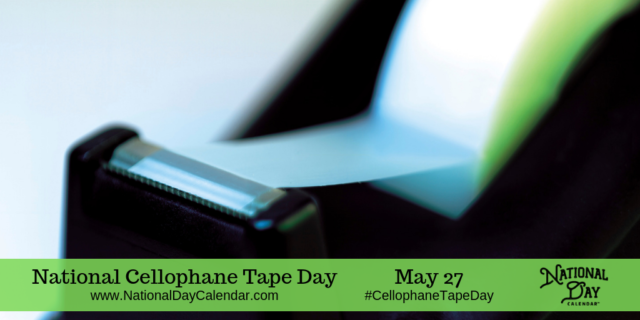
Observed annually on May 27th is National Cellophane Tape Day. It is hard to imagine where we would be without this invention.
- This everyday household and office item, which is also known as invisible tape or Scotch Tape, was invented by Richard Gurley Drew (June 22, 1899 – December 14, 1980). Drew joined the 3M Company in St. Paul, Minnesota in 1920, first inventing the masking tape in 1926, followed by the invention of the cellophane tape in 1930.
- Originally designed to seal Cellophane packages sold in grocers and bakeries, the new adhesive missed its mark. By the time all its drawbacks were resolved, DuPont introduced heat-sealed cellophane.
- Cellophane tape was invented in the 1930’s with the purpose of putting a seal on an amazing new substance called, you guessed it, cellophane.
- In 1953 it was revealed that if you take cellophane tape and put it in a vacuum, and then peel it, it will fire off x-rays. Further research revealed that this emission of x-rays was enough to leave an x-ray of a finger on photo paper.
- One of Drew’s responsibilities at 3M was to deliver samples of sandpaper to local automotive shops for testing, where he often overheard workers who were painting complain about the problems with tape used for these paint jobs. The twenty-three year old then lab assistant got the idea to create a new tape that would create a seal so that the paint wouldn’t get through and yet also come off clean without leaving any sticky residue that ruined the paint finish.
- In 1929, his position as technical director at the fabrication laboratory allowed him to pursue another idea. Cellophane had recently been invented by DuPont and was being used by grocers and bakers as a neat way to package their groceries.
- Drew went straight to work when he learned that a St. Paul insulation firm needed 3M’s help in devising a waterproof covering for the insulation batts that it was designing for railroad refrigerator cars.
- On Sept. 8, 1930, the first roll of Scotch™ Cellophane Tape was sent to a prospective customer. That customer wrote back with the following sound advice for 3M: “You should have no hesitancy in equipping yourself to put this product on the market economically. There will be a sufficient volume of sales to justify the expenditure.”
- Scotch® Tape: Great Depression-era Fix-all and Scotch® Legacy. In an era when thrift wasn’t just a virtue, but a necessity, Scotch® Brand Cellulose Tape virtually sold itself. Almost daily, new ideas sprang up for using the tape to make old things do. It was used to mend book pages, sheet music, window curtains, and even small rips in clothing. Bankers used it to repair paper currency. Secretaries found it perfect for patching broken fingernails. Farmers discovered they could use it to seal cracked eggs. Housewives used it to cap canned milk, remove lint from clothing, secure bait on mousetraps, and repair cracked ceiling plaster. Goodyear used the tape to cover the inner ribs and beams of its dirigibles, creating an anti-corrosive shield.
- The tape that Dick Drew conceived so many years ago has been to the moon (as insulation on a lunar lander), featured on Saturday Night Live, and immortalized in fine art. But Drew, who died in 1980 at age 81, never gave up trying to find something better. As a result of his tinkering, which was continued by those who followed in his footsteps, 3M developed a number of breakthrough adhesive products including 3M Micropore™ Surgical Tape®, Scotch® Pop-Up Tape Strips, and Post-it® Notes. Yet despite his many successes, which led to his 2007 induction into the National Inventors Hall of Fame, Drew never forgot how a bit of sandpaper changed his life.
- After cows ate the resin-coated fabric on the rudder section of a 1946 Taylor craft airplane, the plane’s owner, Edward Bridwell, used Scotch Tape to repair it.
- Ornithologists have used Scotch Tape to cover cracks in the soft shells of fertilized pigeon eggs, allowing the eggs to hatch.
- Landlords in Bangkok, Thailand, have used Scotch Tape to repair cracks in the walls of tenants’ apartments.
- Because the end of Scotch Tape tends to stick to the roll, camouflaged by its transparency, John A. Borden, a 3M sales manager, invented the tape dispenser with a ledge to keep the end of tape away from the roll and incorporating a serrated edge
to cut the tape. - During World War II, 3M stopped selling Scotch Tape to civilians because the military wanted it all. At least one American munitions factory used transparent tape as a conveyor belt to move bullets.
- During World War II, England’s Ministry of Wacky Uses Defense used more than ten million yards on windows to minimize flying glass during air raids.
Sources:












